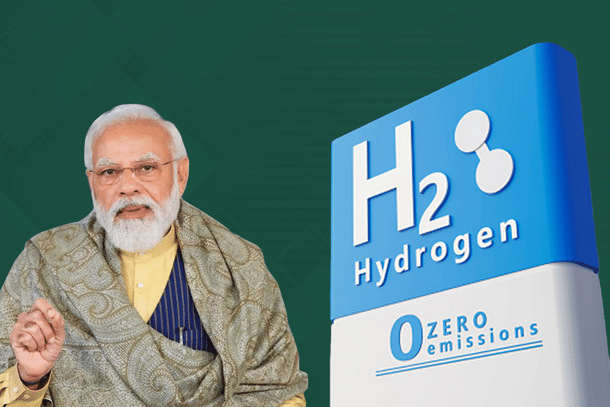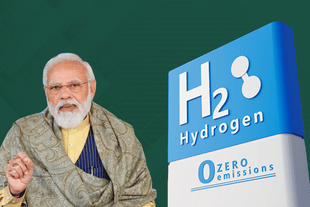Business
India's Green Hydrogen Sector Continues Attracting Investors As Behemoths Scramble To Tap In
Business Briefs
Apr 13, 2022, 09:54 AM | Updated 10:40 AM IST
Save & read from anywhere!
Bookmark stories for easy access on any device or the Swarajya app.


Green hydrogen is the new energy resource that all of India Inc’s behemoths are scrambling to tap into. Over the last few months, several companies such as Gas Authority of India Limited, Adani Group, Bharat Petroleum, Larsen & Toubro (L&T), Indian Oil Corporation (IOCL), Renew Power and others have declared their intentions to enter the green hydrogen space. Reliance Industries is focused on becoming a producer of blue hydrogen, which is made from methane – the predominant constituent of natural gas.
Of these companies, L&T, IOCL and Renew Power, would be forming a joint venture in order to execute the project. Clearly, these companies believe that green hydrogen could be an effective and large scale source of fuel in a world that is weaning itself off fossil fuels. More recently, Greenko group and John Cockerill declared their plans to build an electrolyser plant in order to secure a part of the green hydrogen value chain. Similarly, IOCL and L&T are planning to come together to produce electrolysers together. In total, it is estimated that larger players such as L&T, Adani, and Reliance alone would pump Rs 6 trillion into the sector.
Green hydrogen is hydrogen produced by the electrolysis of water with renewable energy. The process breaks down the compound water into its constituent two elements – hydrogen and water. Hydrogen can then be used as a fuel for various purposes. Depending on the source of hydrogen, it is classified as grey hydrogen, blue hydrogen, turquoise hydrogen and green hydrogen.
The first three are produced from either methane or coal (in which case it is called black hydrogen), and have a higher degree of pollution compared to green hydrogen. However, the use of renewable energy in the production of green hydrogen ensures that the process does not contribute to carbon emissions. RIL’s focus on blue hydrogen is probably due to its easy access to methane gas, in the form of natural gas. In addition, blue hydrogen has much lower production costs when compared to green hydrogen.
The hydrogen produced is then used in fuel cells that help in the production of clean energy in an efficient manner. While some players like IOCL, L&T and Greenko are focusing on producing the electrodes for electrolysis, others like RIL are exploring the opportunity in fuel cells as well. The company is targeting a price of $ 1 per kilogram for hydrogen, which is a steep reduction from today’s prices. The Adani group, too, is looking at the production of fuel cells and has tied up with Ballard Power Systems for the same.
The industry’s confidence comes in part from the policy push by the Indian government. For the first time, India has come out with a green hydrogen policy. The policy focuses on green hydrogen and green ammonia and includes gases produced from electrolysis and the gases produced from biomass. In order to incentivise producers of green hydrogen, the government has waived off interstate transmission charges for a period of 25 years, for the producers of green hydrogen and green ammonia. The government has proposed to set up manufacturing zones where the plants for green ammonia and hydrogen can be set up. The Ministry of New and Renewable Energy is planning to set up a single portal through which all permissions for production, transportation, and storage can be pursued.
Hydrogen could potentially be a replacement for Lithium – a reactive metal that is mined majorly in countries with socio-economic instability. Unless India finds a sustainable and large source of Lithium, we would certainly not be able to keep up with the surge in demand for the metal as the sales of electric vehicles grow rapidly. Some countries like China have resorted to buying up Lithium miners and mines in order to ensure supply, but India hasn’t progressed on that front. Hence, finding alternate sources of energy is crucial for India’s transition to cleaner energy. Union Minister Nitin Gadkari recently arrived at the parliament in a car that runs on hydrogen, indicating that the government is exploring various options to replace fossil fuels.
But, despite the private sector’s interest and the government push behind green hydrogen, there could be some shorter-term hindrances to large scale production.
For instance, the market for electrolysers is running in a tight demand-supply scenario, with capacity booked till 2025. Other issues include the high cost of green hydrogen production, possibly long lead times for projects to ramp up to large scales, a lack of energy storage for uninterrupted supply of renewable energy, and the high initial investments required in the sector. Hopefully, large scale green hydrogen production can become a reality before 2030, just as the government has targeted.
Also read: India's Hydrogen Economy: The Story In Mission Mode





